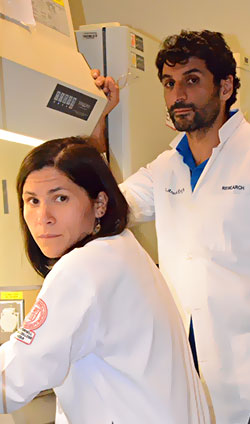Scientists create blood in the laboratory
 Dr. Jennifer Pasquier and Dr. Arash Rafii Tabrizi
Dr. Jennifer Pasquier and Dr. Arash Rafii Tabrizi
Researchers at Weill Cornell Medicine – Qatar have made a breakthrough which could lead to personalized blood and heart tissue being created in a laboratory.
Working with colleagues at Pr. Rafii’s Ansary stem cell laboratory at Weill Cornell Medicine in New York, in collaboration with Dr. Arash Rafii Tabrizi’s Lab in Doha postulated that endothelial cells – the cells that line the walls of blood vessels – are responsible for organ development.
Dr. Rafii Tabrizi, whose work has been funded by Qatar National Research Fund, said: “We hypothesized that the endothelial cells are the masterminds of organ development and different organs have different endothelial cells that express different and specific factors called angiocrine factors that lead to the development and function of the organ.”
To test the theory, Dr. Tabrizi and his team isolated endothelial cells and forced the expression of transcription factors using DNA vectors.
After 20 days, the cells began to multiply and were essentially transformed into hematopoietic stem cells, which are the basis for all types of blood cells, including red blood cells, platelets, and white blood cells, which are a vital part of the immune system.
Dr. Tabrizi, who is associate professor of genetic medicine in obstetrics and gynecology at WCM-Q, said that the next step would be to translate the research to a human model, to test whether the findings can be translated to tackle different human diseases
Dr. Tabrizi said: “If you have leukemia, for example, we would retrieve your endothelial cells and we could transform that into blood. It would be an unlimited personal source of blood for each individual. However, it is too early at this stage to make these assumptions in the absence of concrete human data”
Importantly the power of the endothelium to support cellular differentiation for blood cells is also successful with cardiac cell regeneration. By combining endothelial cells with cardiomyocytes – the heart’s muscle cells – the researchers were able to create muscle cells in a petri dish that beat together in a regular rhythm, similar to endogenous cardiomyocytes.
Dr. Jennifer Pasquier, research associate in genetic medicine at WCM-Q who performed these experiments said: “Some organs function to secrete substances so, for example pancreatic cells would have to be sensitive to blood sugar levels and secrete insulin. But for cardiac cells we want them to integrate and beat in synchrony with each other. The problem is, if you transplant cardiac cells into your heart and then they beat at a different rate from the other cells, this would be the catastrophic for the individual.”
However, the research team believes that the endothelial cells are creating a ‘bridge’ between the cardiac cells, ensuring they act as one and as they would in the human heart. If true, the technique could one day be used to help heal cardiac infractions or support people with a heartbeat too weak due to degenerative heart disease such as in ischemic disease or diabetes.
Dr. Tabrizi said: “With an infarction, your heart cells die and are replaced with fibrosis meaning that the cells can’t regenerate themselves. There is no beating in the fibrotic area so this can lead to heart failure. The question is, if we transplant the cardiac cells that have been generated in the laboratory, will they then form a bridge with the existing cardiac cells in the heart?”
At the moment, that is the million-dollar question, so the next step is to create a model of heart ischemia in mice and see if the properties and functionality that the team hopes will be seen are seen.
The research was only possible thanks to support from Qatar National Research Fund with grants NPRP8-1898-3-392 and NPRP 6-1131-3-268.
Dr. Khaled Machaca, Associate Dean of Research at WCM-Q, said Dr. Tabrizi’s research provides an excellent example of how QNRF support of basic research translates into tangible results that are likely to improve the health of the Qatari population in the long term.